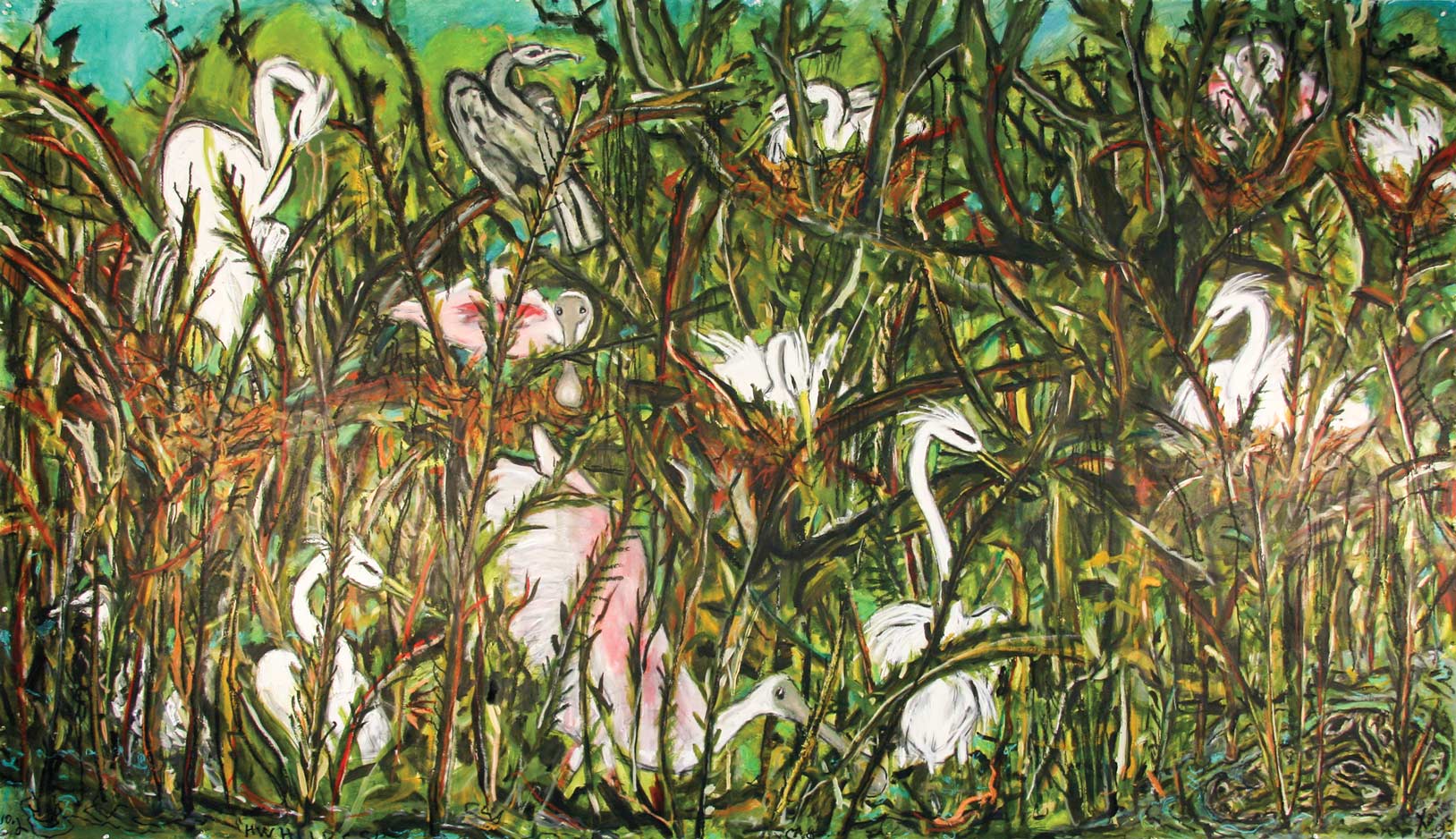
“High Island Rookery” features many of the birds artist Frank X. Tolbert 2 observed daily when he and his wife lived on Galveston Island.
The art aficionados at the opening of Frank X. Tolbert 2’s Texas Bird Project exhibition in Austin were clearly enamored with the artist’s prints, paintings, and drawings of the state’s winged and feathered beings. But the birdwatchers who came to meet the Houston artist were absolutely rapt.
The Texas Bird Project
On display at William Campbell Contemporary Art,
4935 Byers Ave. in Fort Worth.
Hours are Tue-Fri 10 a.m.-5 p.m. and Sat. 11 a.m.-4 p.m.
817-737-9566Tolbert’s works can also be viewed online
williamcampbellcontemporaryart.com
frankxtolbert2.com
“Do you have a life list?” asked one devoted observer of the beaked creatures that soar and beguile. Unassuming and down-to-earth, Tolbert replied that he did not: “But I just really enjoy seeing the birds.”
In that case, the artist hit the jackpot when he was hatched in this neck of the cactus and pine patch. The diversity of Texas’ natural environment—from the mountains and desert to the deep woods and Gulf Coast—makes the state a birder’s paradise where one may behold thousands of species.
While the 72-year-old artist had long been interested in birds, the Texas Bird Project got started in 2014 when Austin’s Flatbed Press & Gallery commissioned him to create eight bird etchings. After unveiling the exhibit at Flatbed, Tolbert said he foresees the project continuing indefinitely into the future.
“Frank has a magical way of interpreting the world with line and color,” said Katherine Brimberry, director and master printer at Flatbed. “These are no ordinary birds. Tolbert’s Texas birds fly artistic boundaries.”
Tolbert got his introduction to the diversity of Texas flora and fauna as a boy when his father, Frank X. Tolbert—a Texas historian, longtime “Tolbert’s Texas” columnist for The Dallas Morning News, and co-founder of the annual Original Terlingua International Championship Chili Cookoff—took him on Jeep excursions to every section of the state. The trips made a deep and lasting impression on young Frank.
The diversity of Texas’ natural environment—from the desert to the deep woods—makes the state a birder’s paradise.
“I remember one time we were in Wizard Wells in Jack County,” Frank said. “Tarantulas were all over the walls of a filling station. The whole road was black with tarantulas. My dad said it must be tarantula mating season. I’ve never seen anything like it since.”
When Frank was 9, his dad took him on a colossal Jeep trek around the perimeter of Texas. The next year he began studying with artist Otis Dozier—a member of the famed “Dallas Nine” group of artists of the 1930s—taking art lessons at the Dallas Museum of Fine Arts when it was located at Fair Park. Tolbert remembers wandering around the museum and seeing a painting by Mexican artist Rufino Tamayo of a man reaching for a shooting star.
“I’ve lived all of my life in Texas, and I feel like my art is sort of a visual diary where the folklore of Texas and my personal life are inseparably intertwined,” he said. “But I’ve also traveled a lot in Mexico, and I see my work as kind of a combination of Otis Dozier’s Wild West heroism and Rufino Tamayo’s magical realism.”
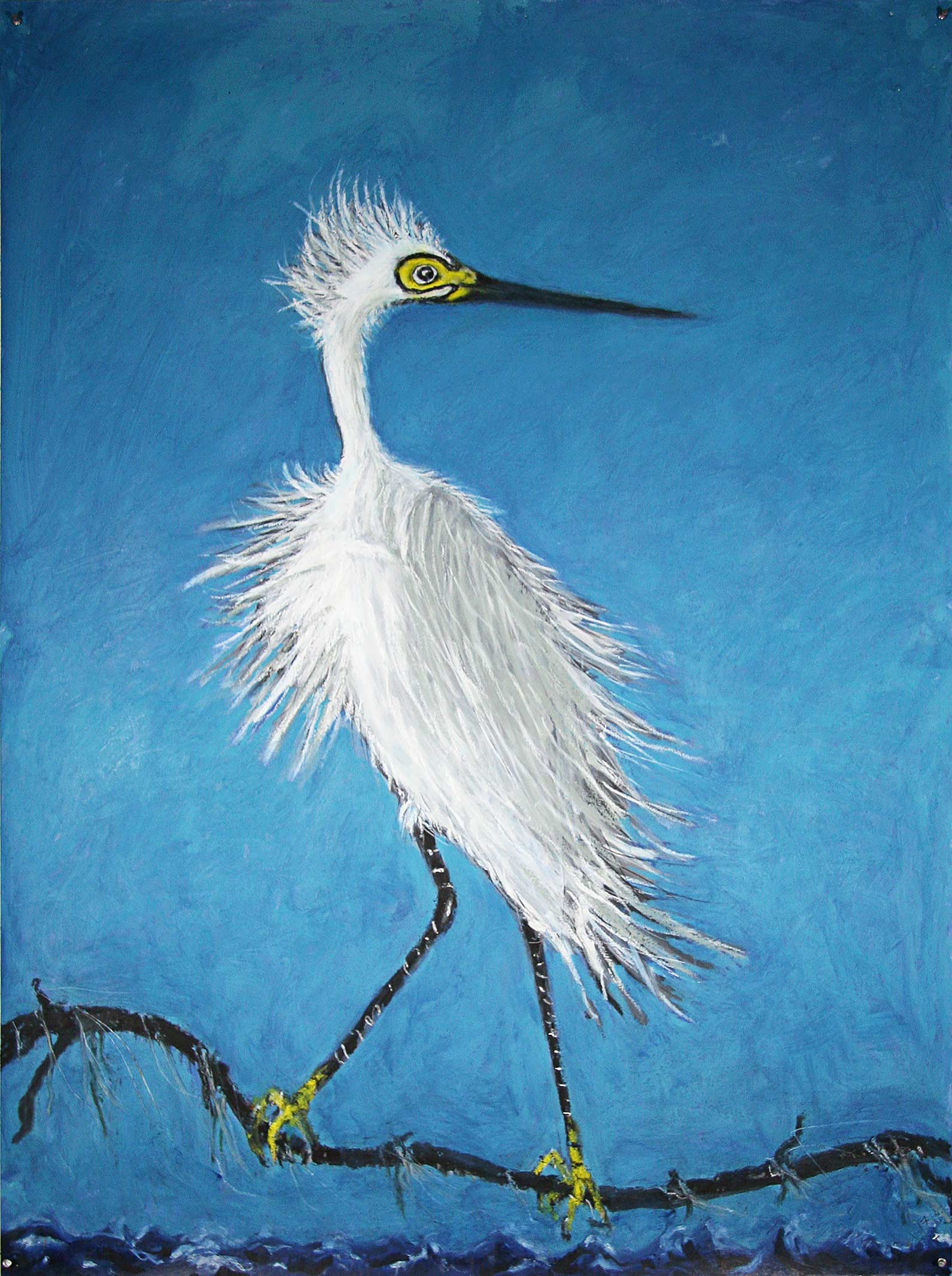
Snowy egret
The artist experienced the abundance of coastal bird populations daily when he and his wife, artist Ann Stautberg, lived on Galveston Island. Frequent visits to Smith Oaks Sanctuary on High Island provided Tolbert with prime viewing of birds such as the roseate spoonbill. His 6-by-11-foot oil painting on paper, High Island Rookery, features several of the distinctive birds.
“That bird has an amazing history,” Tolbert said. “It almost became extinct in the 19th century because hatmakers wanted the beautiful plumes for hats.” Noted not only for its eye-catching pink and red feathers but also for its long bill that it uses to scoop up small fish and crustaceans, the roseate spoonbill began to recolonize in the early 1900s.
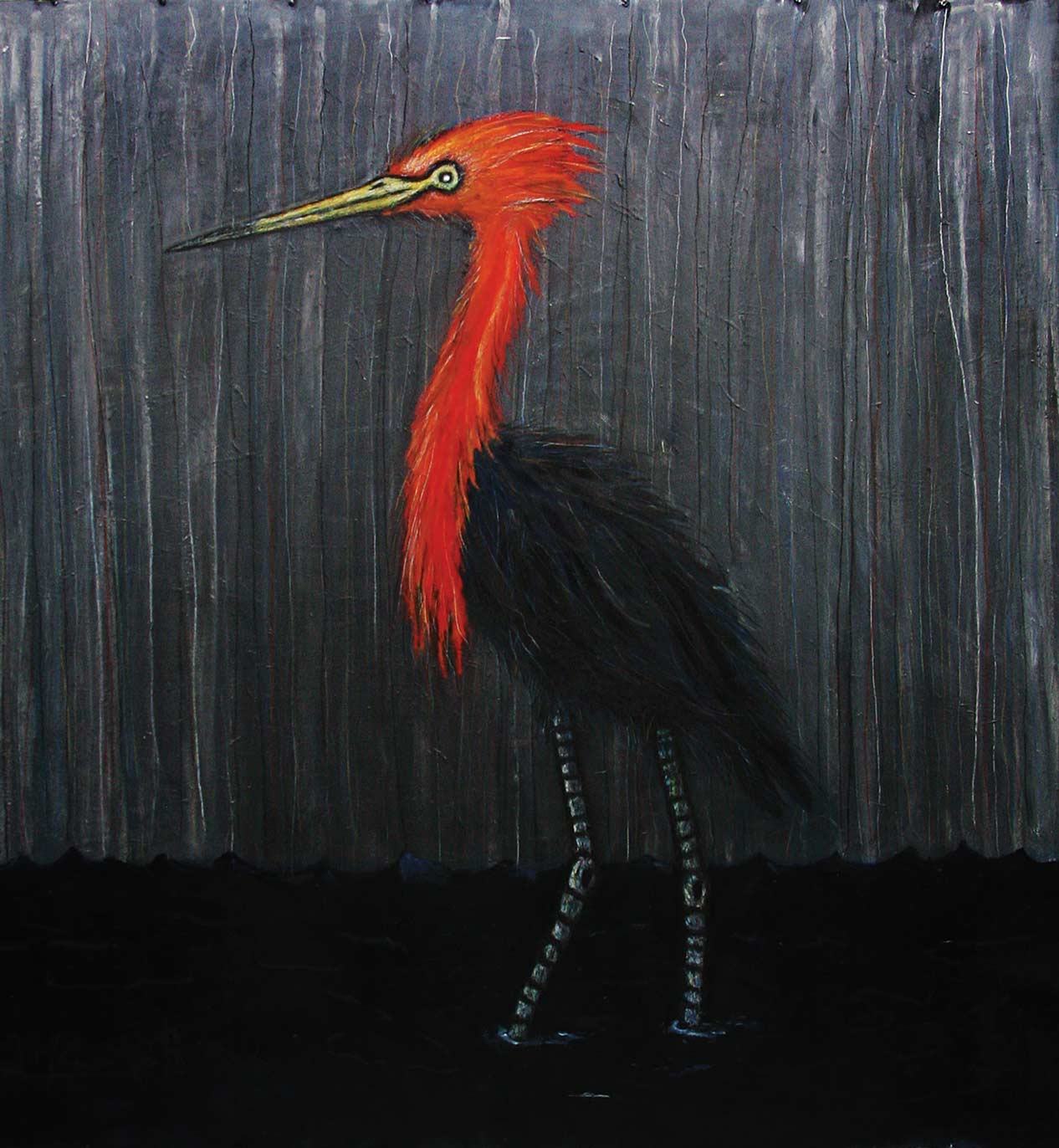
Reddish egret
Aside from visits to Smith Oaks, Frank has done most of his bird sighting for artistic purposes in less structured settings. “I’ve painted and drawn lots of birds, like the pileated woodpecker, that I saw in my own backyard,” he said. His color etching Pileated Woodpecker is printed on Rives BFK, a cotton printmaking paper from France. The species’ distinctive red crest looks as though it is adorned with a flaming Mohawk hairdo, and its long bill chisels into trees like a jackhammer.
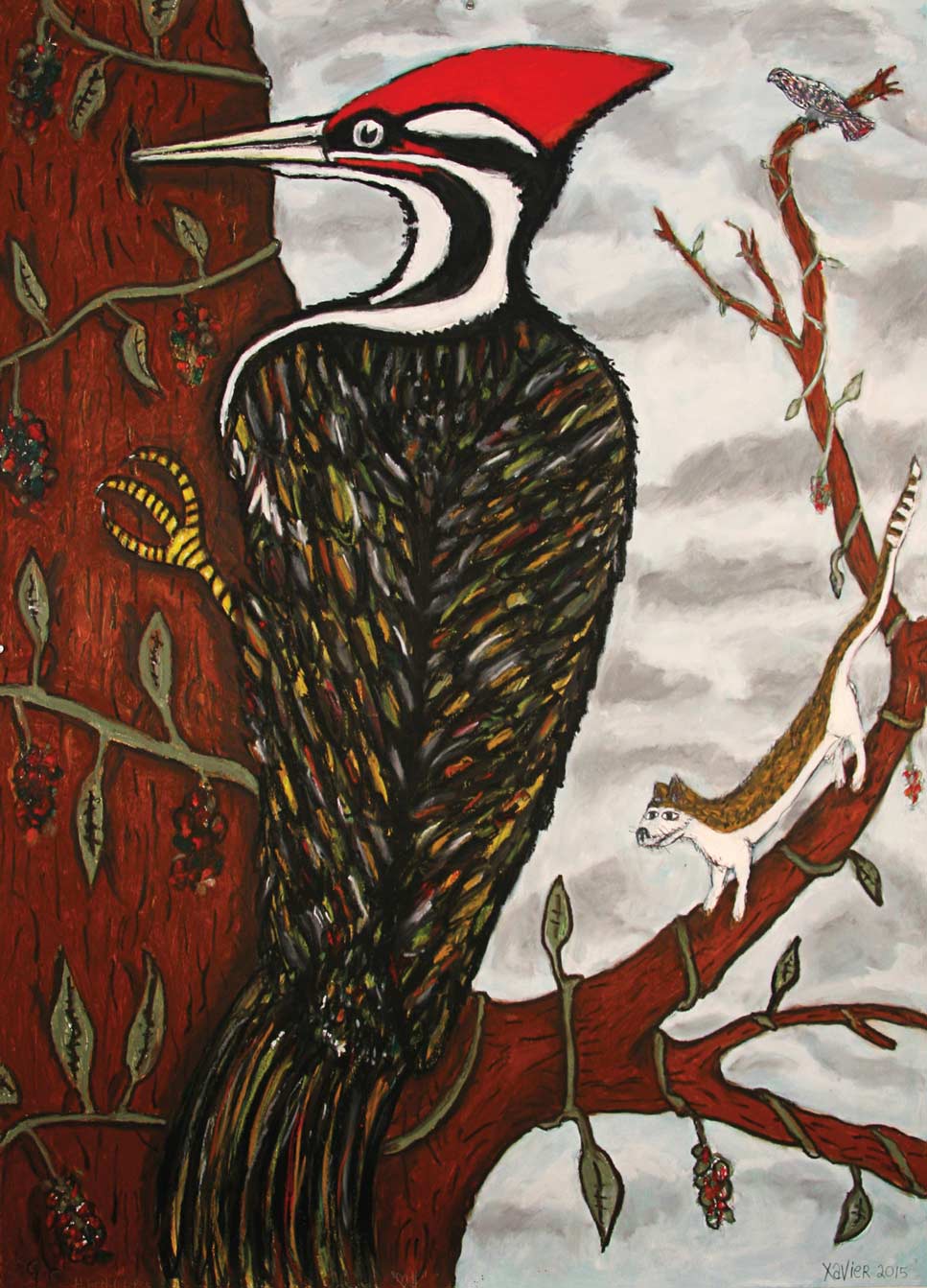
Pileated Woodpecker
Frank spied his great horned owl outside the Devil’s Sinkhole near Rocksprings. Said to have the most diverse diet of all North American raptors, the great horned owl will even eat the Mexican free-tailed bats that emerge from the sinkhole on summer eves. Tolbert’s oil stick and graphite work on paper, Great Horned Owl, stares at the viewer with large hypnotic eyes.
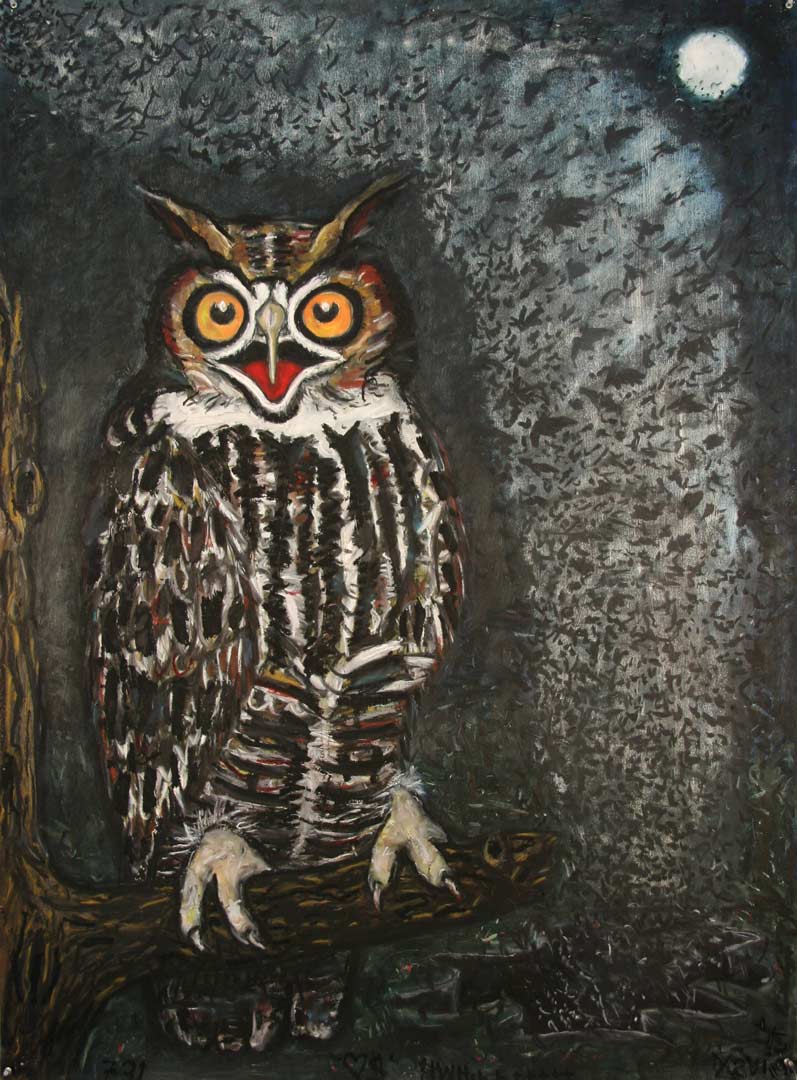
Great Horned Owl
The artist recalls seeing a ruby-throated hummingbird in the Hill Country, but on rare occasions the small bird with a bright-red kerchief and rapid-fire wings (beating 50-plus times per second) can be spotted in Big Bend, where Tolbert has often rambled. In his color etching Ruby-throated Hummingbird, the crimson-necked hummer hovers over a prickly pear cactus, its long sharp beak drinking nectar from the plant’s flower. A praying mantis, which preys on hummingbirds, sneaks stealthily up the nopal pad.
The project, which started as etchings and grew to include paintings, also includes egrets, crows, herons, jays, and pelicans, all depicted with a vivid emotional element that surpasses photographs.
“Frank has a magical way of interpreting the world with line and color. These are no ordinary birds. Tolbert’s Texas birds fly artistic boundaries.”
The Texas Bird Project is the latest installment in a long career that has made Tolbert one of the state’s leading contemporary artists. “His decades worth of expressive notations on the common sights of daily life place him in the first rank of Texas artists who see quotidian details as rich sites for shared experience,” said independent curator Annette Carlozzi, who is writing a book on the contemporary Texas art scene for University of Texas Press.
Quotidian details abound in Texas birds. “The abstractions of their markings and colors are incredible creations of nature that you could never improve—you just try to bring them to life,” Tolbert said. “Birds are just amazing.”








